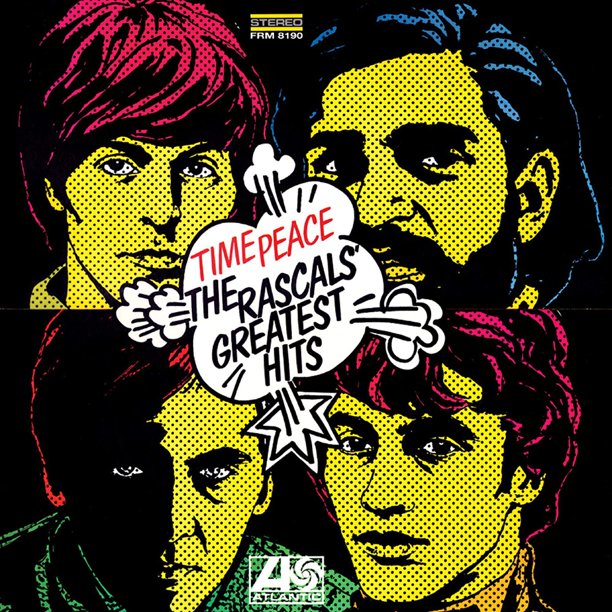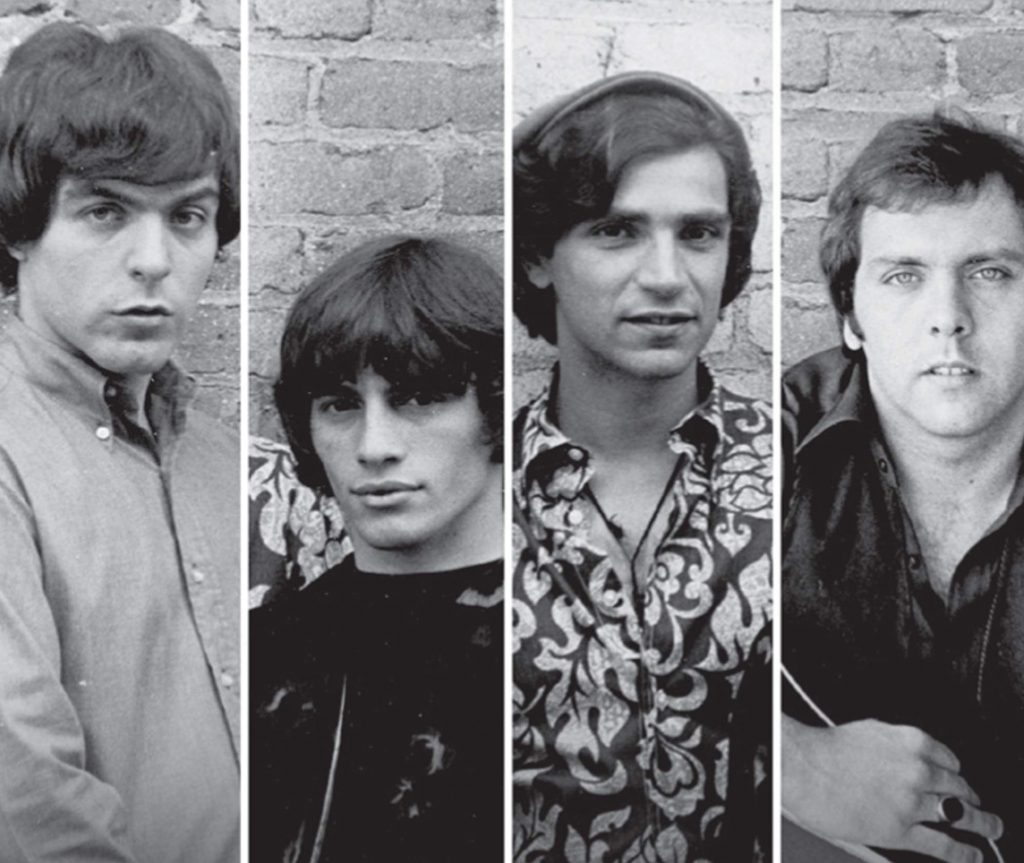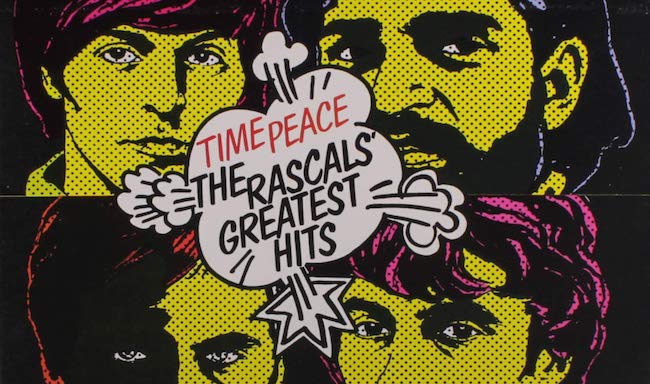 Time Peace: The Rascals Greatest Hits marked both the culmination of the former “Young” Rascals’ early career and the transition to a new beginning. More than the “best of” it was intended as, it was an effective compilation of the seminal hit singles the band amassed during its chart-topping seminal period, from 1965 throughout 1968, beginning with their first record to capture attention, “I Ain’t Gonna Eat Out My Heart Anymore,” through to 1968’s chart-topper, “A Beautiful Morning” (A.K.A. “It’s a Beautiful Morning”).
Time Peace: The Rascals Greatest Hits marked both the culmination of the former “Young” Rascals’ early career and the transition to a new beginning. More than the “best of” it was intended as, it was an effective compilation of the seminal hit singles the band amassed during its chart-topping seminal period, from 1965 throughout 1968, beginning with their first record to capture attention, “I Ain’t Gonna Eat Out My Heart Anymore,” through to 1968’s chart-topper, “A Beautiful Morning” (A.K.A. “It’s a Beautiful Morning”).
Not surprisingly, Time Peace, released on June 24, 1968, topped the U.S. album sales chart and enjoyed an extended run that lasted some 20 weeks. Just as significantly, it documented the trajectory of a group that initially made its name as a white group that could purvey pure R&B. Many didn’t realize until much later that they themselves weren’t a black band. That said, their visual image certainly didn’t lend itself to that impression, given the attempt to exploit the “rascally” persona by dressing in knickers, wide-collared shirts and caps of a schoolboy variety.

Nevertheless, The Rascals were clearly more than a novelty. They became an international sensation, appearing on The Ed Sullivan Show and even opening for the Beatles at Shea Stadium. More importantly, they were a potent instrumental outfit. Felix Cavaliere’s trademark organ flourishes helped define their sound, while guitarist Gene Cornish proved an able resource when it came to driving them; the relentless riffing on one particular song on Time Peace, “Come On Up,” serves as a prime example. As for Dino Danelli, suffice it to say he remains one of the most underrated drummers in the annals of rock ’n’ roll, a powerhouse performer very much in the same vein as Keith Moon.
As time went on, the Rascals began to veer away from the R&B covers that had helped sustain them early on. While several early offerings that were penned by others had a prominent place on Time Peace—specifically their first big hit, “Good Lovin’,” and the perennial soul standards “Mustang Sally” and “In the Midnight Hour”—the album also effectively documents the evolution of the Cavaliere/Eddie Brigati songwriting team. (Brigati, who initially sang lead and took the fore on “I Ain’t Gonna Eat Out My Heart Anymore,” eventually ceded that role to Cavaliere and settled instead for backing vocals and percussion.)
Related: Who were some of the greatest blue-eyed soul singers?
The two made their mark as co-writers, with several of the songs on this collection—“You Better Run” (later a hit for Pat Benatar), “Love Is a Beautiful Thing,” “A Girl Like You,” “How Can I Be Sure,” “It’s Wonderful,” “It’s a Beautiful Morning” and, of course, “Groovin’”—serving as their standards.
Those songs also reflected the fact that, at this point, the Rascals could be considered more than a mere a pop band. “Love Is a Beautiful Thing,” “Beautiful Morning” and “A Girl Like You” found them expanding their instrumental arsenal with brass and orchestration. (Listen to the inventive combination of harps and horns that embellish the latter.) They incorporated jazz influences as well, soliciting contributions of such renowned musicians as flutist Hubert Laws to place them on the periphery of a more progressive posture.
On the other hand, the selections credited solely to Cavaliere, “Come Up Up” and “(I’ve Been) Lonely Too Long,” dealt mainly with courtship, love and occasional heartbreak, but managed to do so in a way that was as personal as they were poignant. It was a theme echoed early on with “I Ain’t Gonna Eat Out My Heart Anymore” and later through any number of other songs in this collection, including “You Better Run,” “Love Is a Beautiful Thing” and “How Can I Be Sure.”
So while Time Peace could be considered a document detailing the end of an era, it also marked a makeover. The album that preceded it, Once Upon a Dream, was an attempt to break from their commercial constraints and offer instead a conceptual offering that Cavaliere wistfully referred to as an attempt at a “Sgt. Pepperish” production. They would continue in that vein long after Time Peace as well, releasing a string of ambitious epochs—Search and Nearness, See, Peaceful World and The Island of Real—well into the early ’70s.
Time Peace foretold that evolution, both in the double meaning that could be ascertained from the title, as well as in the innovative gatefold album cover boasting an art nouveau cover drawing and an interior photo of the band in psychedelic garb.
The Rascals were clearly at peace with their new image, and time was, in fact, marching on.
Incredibly, the group’s “People Got To Be Free,” was released as a single on July 1 but wasn’t included on the Time Peace album, which had been issued just a week earlier. It became the band’s third song to reach #1. (It was included months later on their 1969 album, Freedom Suite.)
Watch the Young Rascals perform “Good Lovin'” on The Ed Sullivan Show in 1966


6 Comments
This may be the BEST album that I ever purchased. I still have it, 50 plus years later.
Oh my goodness, “TimePeace” was/is one of the most beloved collections I had as a youngin, and one of my most favorite LPs of all time. The thing is, the Rascals was a band of guys that were basically weaned, musically, from the late fifties through the early sixties. So they had an early rock n’ roll sensibility, along with, of course, a lot of R&B in their blood. The band was spawned at a time when singles played incessantly on AM radio was still the epicenter of the popular musical world. And they did that brilliantly, bringing some of the greatest, creative, wide-ranging, multi-genre, and rockin music ever to the radio and television waves. But over the course of their success, they ran into, and kind of breeched the gap into FM radio and fans listening to whole LPs. And though they tried, with a couple of solid efforts, to be a part of the late 60s musical movements, they never were really able to get beyond being a brilliant singles band. Even for an avowed Rascals fanatic like myself, in listening to the Rascals LPs, it’s remarkable what an immense gap there is from the hits to the rest of the LPs in song quality, sonic quality and production value. It’s as if their record company through in everything they had to create their singles, but then just said, “Ahh,….do what you want with the rest, but we spent most of our production budget on the hit, so do what you can.” Consequently, the band had little success breaking into the album era of rock music. It’s hard to understand why they couldn’t come up with, at least, better songs for their albums, especially considering what great songs their hits were. But at least the were smart enough to make those “hits” count for one truly incredible LP in “TimePeace.”
Always a pleasure to read up on The (Young) Rascals. Thanks & keep Groovin’ to Come on Up w/more Rays of Hope….
Not an Art Nouveau cover at all but likely the most and best Pop Art cover of any rock album. Ben Day dots are right out of Roy Lichtenstein.
I am pretty sure, having read both Felix’s and Gene’s books, that the Rascals did not open for the Beatles at Shea. The Beatles and the Rascals did have promoter/manager Sid Bernstein in common. The Rascals were at the show at Shea (they were in the dugout), but they did not perform.
I don’t think of the Rascals as an album band but Groovin is their pop masterpiece. Their other hits groove as well.